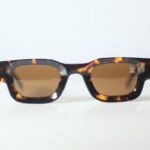Expert Guide: How to Tell If Sunglasses Are Polarized

Welcome to the expert guide on how to determine if sunglasses are polarized. As you embark on the journey of finding the perfect pair of sunglasses to shield your eyes from harmful UV rays, it’s crucial to understand the importance of polarization. As a seasoned optometrist with over 15 years of experience, I am here to shed light on this often-misunderstood topic. Through my extensive knowledge of lens technology and expertise in analyzing visual properties, I will provide you with valuable insights to help you make informed choices when it comes to purchasing polarized sunglasses.
How to Tell If Sunglasses Are Polarized: Your Expert Guide
Are you curious to know whether your sunglasses are polarized? As a seasoned optometrist with over 15 years of experience, I can help you understand the telltale signs of polarized sunglasses. By following a few simple methods, you can easily determine if your eyewear has this beneficial feature. Let’s dive in and explore how to tell if sunglasses are polarized.
Method 1: The Optical Store Test
One straightforward way to check if your sunglasses are polarized is by visiting an optical store. Once there, position the lens of your sunglasses at a 90-degree angle to the lens of a polarized pair. Observe closely as the lenses of both sunglasses combine. If they turn dark or nearly black, congratulations! Your sunglasses are polarized. This occurs because the overlapping polarized filters in the lenses reduce light transmission, resulting in a darker appearance.
“By performing the optical store test, you can easily determine if your sunglasses possess the coveted polarized feature.”
Method 2: The Computer Screen Test
If visiting an optical store is not an option, don’t worry! You can still assess the polarization of your sunglasses using the computer screen test. Begin by holding your sunglasses up to your computer screen and pay close attention to what happens when you rotate them 90 degrees. If the lenses become noticeably dark or obstruct your view, it’s a strong indication that your sunglasses are polarized.
“The computer screen test offers a convenient way to determine if your sunglasses provide the desirable polarized effect.”
Method 3: The Lens Markings Check
Another quick method to verify the polarization of your sunglasses is to inspect the lenses for markings. Some sunglasses manufacturers include a sticker on one of the lenses explicitly stating that the glasses are polarized. In some cases, you may even find the word “polarized” etched into the bottom edge of the left lens. These markings serve as a clear indicator that your sunglasses have the glare-reducing and visibility-enhancing properties of polarized lenses.
“By carefully examining the lenses of your sunglasses, you can easily spot any visible markings that confirm their polarized nature.”
So, why should you bother determining if your sunglasses are polarized? Well, polarized sunglasses offer valuable benefits like reducing harsh glare and enhancing visual clarity in certain situations. Whether you’re driving under the glaring sun, engaging in outdoor activities, or simply relaxing by the water, polarized sunglasses excel at reducing eye strain and providing a more comfortable viewing experience.
To experience the advantages of reduced glare and improved visibility, it’s essential to ensure that your sunglasses are indeed polarized.
While knowing how to tell if sunglasses are polarized is important, it’s equally vital to maintain your sunglasses properly. Regularly clean your lenses using a microfiber cloth and a gentle cleaning solution specifically designed for eyewear. Additionally, choose the right pair of sunglasses that suits your needs, ensuring they provide sufficient protection against harmful UV rays.
By cleaning your sunglasses correctly and selecting the perfect pair, you can preserve their polarized benefits and enjoy enhanced eye health.
To recap, there are several methods for determining whether your sunglasses are polarized. You can try the optical store test, where darkening lenses indicate polarized eyewear. The computer screen test involves observing whether the lenses darken or obstruct your view when rotated. And don’t forget to check for any visible markings on the lenses, such as stickers or etchings.
With these simple methods at your disposal, you can quickly and confidently ascertain if your sunglasses possess the coveted polarized feature.
In conclusion, understanding how to tell if sunglasses are polarized empowers you to make informed decisions when purchasing eyewear. By applying these methods and recognizing the signs of polarization, you can enjoy the benefits of reduced glare and improved visibility while safeguarding your eye health.
“Now that you’re armed with the knowledge to identify polarized sunglasses, you can confidently choose eyewear that provides optimal eye protection and visual comfort.”
Sunglasses have been a staple accessory for decades, not only providing protection from the sun’s harmful rays, but also making a bold fashion statement. Did you know that there are some fun facts about sunglasses that might surprise you? Discover the fascinating history and intriguing trivia about these stylish eyewear pieces by clicking here: fun facts about sunglasses. Prepare to be amazed as you uncover the secrets behind the iconic sunglasses that have graced the faces of celebrities and fashionistas alike. So go ahead, delve into the world of sunglasses and unravel the intriguing stories that lie behind this fashionable accessory.
How Can You Determine If Sunglasses Are Polarized?
[youtube v=”7KSWQAceo6g”]
Exploring Different Methods to Determine Polarization
In this section, we will discuss various methods to determine if sunglasses are polarized or not. One straightforward method is the optical store test, which involves combining the lenses of two pairs of sunglasses to see if they turn dark. Another method is the computer screen test, where you rotate the sunglasses in front of a computer screen to see if the lenses darken or obstruct the view. Additionally, you can check the lenses for markings that indicate they are polarized.
The Optical Store Test
One method to determine if sunglasses are polarized is the optical store test. To perform this test, you need two pairs of sunglasses. First, hold one lens from each pair in front of you and try to look through them. If they turn dark or block your view, it indicates that one or both lenses are polarized. This is because polarized lenses have a special coating that reduces glare and enhances visual clarity.
The Computer Screen Test
Another way to determine if sunglasses are polarized is by using the computer screen test. For this test, you will need a computer screen or any device with actual pixels, such as a phone or TV. Hold the sunglasses in front of the screen and start rotating them. If the lenses darken or obstruct your view at a certain angle, it suggests that they are polarized. This happens because polarized lenses are designed to reduce glare and improve visibility, especially in bright light conditions.
Checking for Markings
In addition to the optical store and computer screen tests, you can also check the lenses for markings that indicate they are polarized. Many polarized sunglasses have a small “P” or “Polarized” label etched or printed on the lens. Look closely for these markings, especially if the sunglasses are not clearly labeled as polarized or non-polarized.
Importance of Polarized Sunglasses
Understanding if sunglasses are polarized is crucial as polarized lenses offer several benefits. They significantly reduce glare caused by sunlight reflecting off shiny surfaces like water, snow, or roads. This reduction in glare enhances visual clarity, making outdoor activities more enjoyable and safer. Whether you’re driving, participating in water sports, or simply enjoying a sunny day, polarized sunglasses can provide a greater level of eye protection and comfort.
Proper Maintenance for Long-Lasting Polarized Benefits
To preserve the benefits of polarized sunglasses, it is vital to clean and maintain them properly. Use a microfiber cloth or a lens cleaning solution specifically designed for sunglasses to clean the lenses regularly. Avoid using abrasive materials that may scratch the lens or damage the polarization coating. Additionally, store the sunglasses in a protective case when not in use to prevent any potential damage.
Informed Decision-Making for Eye Protection
By knowing whether sunglasses are polarized or not, individuals can make informed decisions about the type of eyewear that best suits their needs. Whether it’s for outdoor activities, driving, or everyday use, understanding the polarization feature can help protect your eyes and enhance your visual experience.
As the transcript from the video suggests, there are various methods, including the optical store test, the computer screen test, and checking for polarized markings, to determine if sunglasses are polarized. Polarized sunglasses are beneficial as they reduce glare and improve visual clarity. It is important to maintain and clean sunglasses properly to enjoy their polarized benefits for a long time. By being aware of whether sunglasses are polarized or not, individuals can make informed decisions and effectively protect their eyes.

FAQ
Question 1: Can I determine if my sunglasses are polarized without visiting an optical store?
Answer 1: Yes, there are a few simple methods you can try at home to check if your sunglasses are polarized. You can place the lens of your sunglasses at a 90-degree angle to the lens of polarized sunglasses. If the combined lenses turn dark or nearly black, your sunglasses are polarized. Another method is to hold your sunglasses up to a computer screen and rotate them 90 degrees. If the lenses become dark or you can no longer see through them, they are polarized. Look for a sticker on one of the lenses stating that the glasses are polarized, or some companies even etch the word “polarized” into the bottom edge of the left lens.
Question 2: What are the benefits of wearing polarized sunglasses?
Answer 2: Polarized sunglasses provide several benefits for eye health. They reduce glare from surfaces such as water, snow, or shiny objects, improving visibility and comfort. This makes them particularly useful for outdoor activities like driving, boating, skiing, or fishing. Polarized lenses also enhance contrast and clarity, allowing you to see details more clearly. By blocking harmful UV rays, polarized sunglasses can help protect your eyes from sun damage and reduce the risk of conditions such as cataracts and age-related macular degeneration.
Question 3: Do all sunglasses offer polarized lenses?
Answer 3: No, not all sunglasses are polarized. Polarized lenses require a special manufacturing process to eliminate glare, which increases the cost of production. Therefore, polarized sunglasses are usually more expensive than non-polarized ones. When purchasing sunglasses, it’s important to check if they have polarized lenses if that is a feature you desire. Look for labels or descriptions that specifically mention “polarized” to ensure you are getting the desired benefits for your eyes.
Question 4: How can I maintain my polarized sunglasses?
Answer 4: To maintain your polarized sunglasses, it’s important to clean them properly. Use a soft microfiber cloth or lens cleaning solution designed for eyewear to gently wipe away any smudges or dirt. Avoid using harsh chemicals or abrasive materials that could scratch the lenses. When not in use, store your sunglasses in a protective case to prevent damage. Additionally, avoid leaving your sunglasses in hot environments, such as inside a car, as excessive heat can warp the frames or damage the lenses.
Question 5: How do I choose the right pair of polarized sunglasses for my needs?
Answer 5: When selecting polarized sunglasses, consider your lifestyle, activities, and personal preferences. Look for sunglasses that provide 100% UV protection, as this is essential for shielding your eyes from harmful rays. Consider the lens color, as different tints can enhance or alter your perception of colors. Darker tints like gray or green are versatile and reduce overall brightness, while brown or amber tints enhance contrast and depth perception. Frame style and fit are also important factors. Choose a design that suits your face shape and provides comfort for long durations. Consider polarized sunglasses with additional features such as anti-reflective coatings, scratch-resistant coatings, or wraparound designs for added protection.
- China II Review: Delicious Food & Speedy Service - April 17, 2025
- Understand Virginia’s Flag: History & Debate - April 17, 2025
- Explore Long Island’s Map: Unique Regions & Insights - April 17, 2025
















